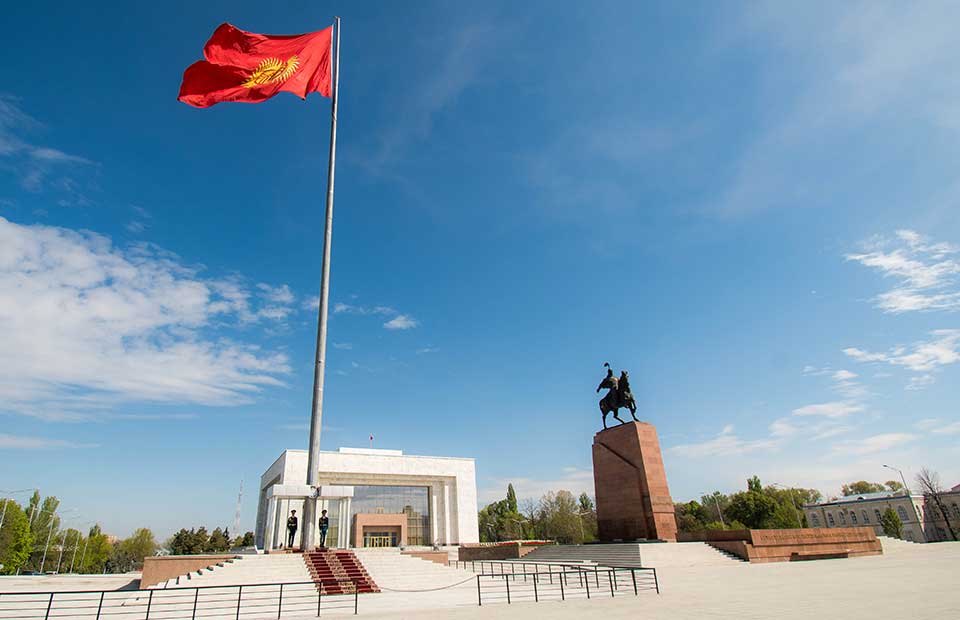The Flag of the Kyrgyz Republic
The flag of the Kyrgyz Republic is a powerful symbol of the nation’s identity and heritage. The Tunduk, the wooden top of the yurt, is prominently displayed in the center of the flag, surrounded by a sun with rays extending outward. This combination of elements represents the Kyrgyz people’s rich history and deep connection to their homeland.
The Tunduk is a traditional symbol of the Kyrgyz nomadic lifestyle and represents unity and harmony within the community. It serves as a reminder of the importance of coming together and working towards a common goal, regardless of individual differences. The Tunduk is also a symbol of the universe, representing the interconnectedness of all things and the cyclical nature of life.
The red field of the flag represents the Kyrgyz people’s fortitude and resilience in the face of challenges. It symbolizes their strength and determination to overcome adversity and protect their way of life. The sun with rays symbolizes peace and prosperity, reflecting the Kyrgyz people’s aspirations for a bright and prosperous future.
In choosing these symbols for the flag, the Kyrgyz people have created a powerful representation of their national identity. By uniting around these symbols, they demonstrate their commitment to preserving their cultural heritage and creating a better future for themselves and future generations. The flag serves as a beacon of hope and inspiration, reminding all Kyrgyz people of the strength and resilience that lies within them.

Flag History
The creation of the Kyrgyz flag was a rigorous process that took place from 1992 to 1994 after the country gained independence. Over 400 sketches were submitted for consideration by a state contest and commission, reflecting the diverse perspectives and creative ideas of the Kyrgyz people.
The final design of the Kyrgyz flag was affirmed by the Decree of the Kyrgyz Republic #91 on July 17, 2004. This new symbol of the country draws on the rich history and cultural heritage of the Kyrgyz people, which can be traced back to ancient times.
According to historical accounts, the first symbols of Kyrgyz tribes were documented in Bulgarian Chronicles, which described a pennant ornamented with ribbons, fixed on the top of a red-colored felt as a symbol of a red snake with wings. This information was also confirmed in the 11th-century manuscript, “Divani Lugat-at-Turk” by Mahmud Kashgari.
The Kyrgyz tribes were distinguished by their heraldic symbols and colors, which were documented in the “Sanjyra” – a history and genealogical division of the Kyrgyz tribes. According to this document, there were three major groups of Kyrgyz tribes: the Right Wing with a blue-colored flag, the Left Wing with a white-colored flag, and the Inner Tribes with a red-colored flag.
However, according to the epic poem “Manas,” which tells the story of the Kyrgyz people’s heroic struggle for independence, the main hero Manas had a red-colored pennant. This symbolizes the Kyrgyz people’s bravery, resilience, and determination to overcome adversity and protect their way of life.
Flag Symbols
The Sun with 40 rays is a powerful symbol on the flag of Kyrgyzstan. The sun is an ancient natural symbol that has been revered by cultures all over the world for millennia. It represents life, energy, and eternal renewal. The light of the sun is a symbol of the source of knowledge, truth, and intelligence. The Sun on the Kyrgyz flag is a symbol of grace and prosperity, shining its light on the people of Kyrgyzstan.
The 40 rays of the Sun on the Kyrgyz flag symbolize the unity of the 40 tribes that make up the Kyrgyz people. The ethnonym “Kyrgyz” is derived from Turkic words meaning “a collection of forty tribes,” so the symbolism of the Sun’s rays speaks to the rich cultural heritage and diverse traditions of the Kyrgyz people.
The yurt, or “Boz-Ui,” is a symbol of Kyrgyz nomadic life and a cornerstone of Kyrgyz culture. It is a top example of nomadic architecture, and its circular shape is reminiscent of the Sun and Moon. The Tunduk, or circular opening at the top of the yurt, represents the universe and serves as the only window to the outside world. It is a symbol of family, community, and the continuation of life, representing peace and harmony.
The color red is deeply significant in Kyrgyz culture. It represents fire, the sun, energy, and life itself. While some may associate the color with blood and violence, the Kyrgyz people view it as a symbol of new beginnings and the start of life. Red-colored clothes and accessories are widely used in everyday life for protection from the evil eye and as a sign of good luck and support.
Taken together, the symbols on the Kyrgyz flag reflect the rich cultural heritage and history of the Kyrgyz people. They speak to the unity, prosperity, and resilience of the Kyrgyz people and inspire a sense of pride and belonging in all who call Kyrgyzstan home.
